Lauder, James David (Captain)
Killed in Flying Accident 1970-11-20
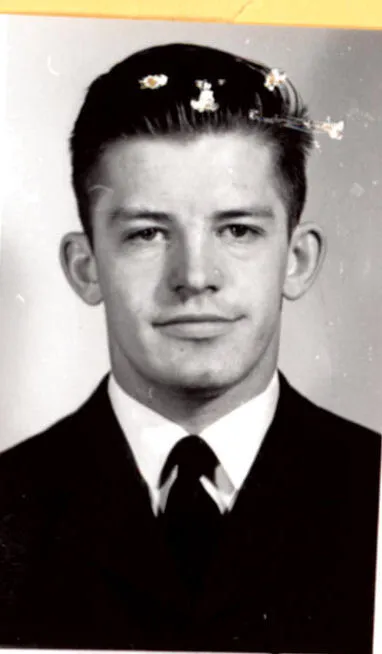

Birth Date: 1941-November-09
Born: Edmonton, Alberta
Son of William McEwan and Ruth (nee Mundy) Lauder and brother of Judith, Terrance and Margaret of Calgary, Alberta
Home: Edmonton, Alberta
Enlistment: Edmonton, Alberta
Enlistment Date: 1962-09-25
Service
RCAF
Unit
410 Sqn- Squadron
Noctivaga Wandering by Night
Base
Rank
Captain
Position
Captain
Service Numbers
94439
Home
 Edmonton, Alberta
Edmonton, Alberta
McDonnell Voodoo CF-101
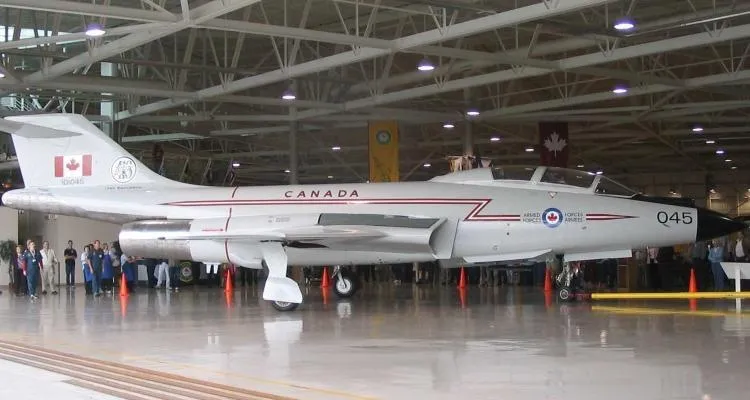
The McDonnell CF-101 Voodoo was an all-weather interceptor fighter operated by the RCAF and the Canadian Forces between 1961 and 1987. They were manufactured by the McDonnell Aircraft Corporation of St. Louis, Missouri for the USAF (as F-101s), and later sold to Canada. Canada purchased F-101s in two batches. The Royal Canadian Air Force purchased 56 F-101B and 10 F-101F aircraft from the United States in 1961. The surviving first batch CF-101s were exchanged in 1970 ââ"�¬â€œ 1972 for 56 lower time USAF F-101B and 10 F-101F aircraft. The second batch of Voodoos served as front line interceptors for the Canadian Armed Forces until the end of 1984. Additionally, one further F-101 (a unique electronic warfare conversion) was leased to Canada from 1982 to 1987.
The Voodoos replaced the obsolete Avro CF-100 Canuck in the RCAF's all-weather fighter squadrons. The Voodoo's primary armament was nuclear AIR-2A Genie unguided air-to-air rockets, and there was significant political controversy in Canada about their adoption. Although they never fired a weapon in wartime, the CF-101 served as Canada's primary means of air defence from Quick Reaction Alert facilities at Canadian airbases. Canadian Voodoo operations finally concluded in April 1987 and on their retirement, they were replaced with McDonnell Douglas CF-118 Hornet fighters. Many examples are preserved in museums and parks in Canada and the USA.
The first deliveries of Voodoos to Canada took place under the designation Operation Queens Row between July of 1961 and May of 1962. The delivery included 25 F-101B-115-MCs and 31 F-10B-120-MCs, all produced in 1959, and ten F-101F two-seat operational trainers, including four F-101F-116-MCs and six F-101F-121-MCs. RCAF CF-101Bs and CF-101Fs were assigned new Canadian serial numbers using the last three digits of their USAF serials prefixed by the number 17. The first 45 CF-101Bs and CF-101Fs entered operational service on 13 Nov 1961 with No. 410 "Cougar" Squadron based at Ottawa, Ontario. Voodoos were flown by No. 409 "Nighthawk" Squadron based at Comox, British Columbia, No. 414 "Black Knight" Squadron based at North Bay, Ontario, No. 416 "Lynx" Squadron based at Chatham, New Brunswick, and No. 425 Squadron "Alouette" Squadron based at Bagotville, Quebec.
In 1970-71, the 46 surviving CF-101Bs and CF-101Fs were exchanged with the USAF for 56 refurbished and modernized F-101B interceptors and ten new F-101F operational trainers under "Operation Peace Wings". These ex-USAF Voodoos were from earlier production batches, but had been upgraded with infrared sensors and improved fire control systems as part of "Project Bold Journey." In Canadian service, this new batch of 66 Voodoos were assigned consecutive serial numbers in the 101001 to 101066 range, with the ten CF-101Fs being given the numbers 101001/101007, 101022, 101024 and 101052. These modernized Voodoos remained in service with Nos. 409, 410, 416, and 425 Squadrons until replaced by McDonnell Douglas CF-188A and CF-188B Hornets in the early 1980s.Harold A Skaarup Web Page
410 Sqn Noctivaga ("Cougar")
History of the Squadron during World War II (Aircraft: Defiant IF, Beaufighter IIF, Mosquito NF II, FB VI, NF XIII,)
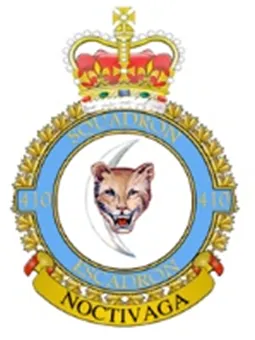
The Squadron was formed at Ayr, Scotland on June 30, 1941 as the RCAF's third Night Fighter squadron to be formed overseas in WWII. It was the ninth RCAF squadron formed overseas. The squadron flew Boulton Paul Defiant, Bristol Beaufighter and later de Havilland Mosquito aircraft in the night air defence of Britain, and then Europe. It was based at a number of locations in the UK before moving to Europe in September 1944, where it remained until the end of hostilities. It was disbanded at Gilze-Rijen, the Netherlands , on June 9, 1945.
In the course of the conflict, the squadron flew 2972 sorties and accounted for 75 enemy aircraft confirmed destroyed, with 2 probables and 9 damaged. Operational casualties were 17 aircraft and 32 aircrew, of whom 10 were killed, 20 presumed killed and 2 POW. The squadron had 10 aces (shot down 5 or more enemy aircraft), of whom 4 were pilots and the others navigators: kills were credited to both crew members (Flight Lieutenant R.D. Schultz DFC&Bar; Flying Officer D.G. Tonque, RAF DFC&Bar (Nav.); Lieutenant A.A. Harrington (USAAF) DSO,DFC; Flight Lieutenant C.E. Edinger DFC; Flying Officer J.S. Christie (RAF) DFC (Nav.); Flying Officer C.L. Vaessen DFC (Nav.); Flight Lieutenant G.P.A. Bodard DFC (Nav.); Squadron Leader J.D. Somerville DSO, DFC; Flying Officer G.D. Robinson DFC (Nav.); Flight Lieutenant V.A. Williams DFC (Nav.). The squadron won 1 DSO, 1 MBE, 2 Bars to DFC, 19 DFCs, 1 BEM and 17 Mentioned in Dispatches. Battle Honours were: Defence of Great Britain 1941-44, Fortress Europe 1943, France and Germany 1944-45 Normandy 1944, Rhine, Biscay 1943.Wikipedia, Kostenuk and Griffin
Maps for Movements of 410 Squadron 1941-45
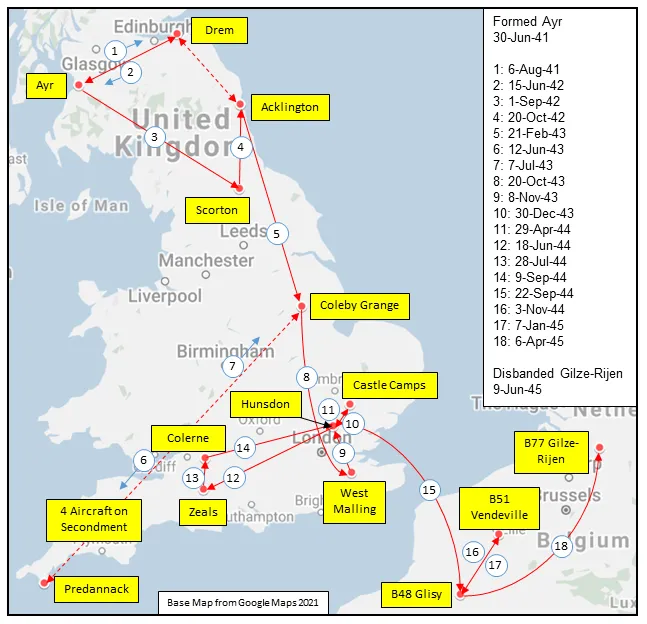
410 Squadron History Summary 1941-45

410 Squadron History Summary 1941-45 Page 2
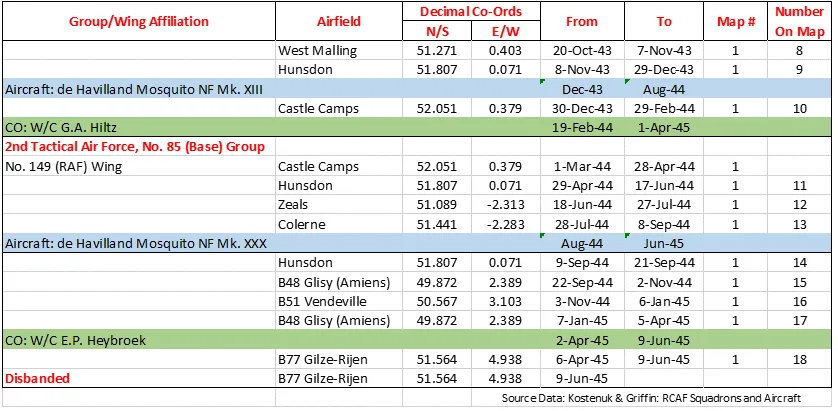
History of the Squadron Post-WWII (Aircraft: Vampire III, Sabre 2, CF-100, Voodoo, Hornet)
The squadron was re-formed in a Fighter role at St Hubert (Montreal), Quebec on 1 December 1948. It was the first post-war Regular Force fighter unit, the first to fly Vampire and Sabre aircraft, and the first to join No. 1 (Fighter) Wing of No. 1 Air Division Europe. In 1956, it was decided to replace one Sabre squadron in each of the Air Division’s four wings with an all-weather fighter unit. When No. 445 AW(F) Squadron arrived from Canada, No. 410 was deactivated at Marville, France on 1 October 1956 and reactivated as All-Weather (Fighter) at Uplands (Ottawa), Ontario on 1 November. The squadron flew CF-100 and CF-101 aircraft on North American air defence until being disbanded on 1 April 1964.
In 1968, No.3 (Operating Training Unit) at CFB Bagotville, Quebec , which was tasked with training pilots and navigators for the three operational RCAF Voodoo squadrons, was renamed No. 410 Squadron. It moved to Cold Lake, Alberta in 1982, changing aircraft to become the training unit for Canada's new CF-18 Hornet aircraft. The squadron’s mission is: To Train World Class Fighter Pilots to Meet Canada's Needs.
The squadron runs two ab initio Fighter Pilot Courses (FPC) each year, training up to 20 fighter pilots. Each course comprises seven intense months of academics, simulator flights and flying missions. Graduates are taken from 419 Tactical Fighter (Training) Squadron (also known as NATO Flying Training in Canada (NFTC) Phase IV) and then provided with the tools to develop a solid foundation in both air-to-air and air-to-ground fighter combat.The squadron is also responsible for training and recertifying approximately five former CF-18 Hornet pilots annually. These are pilots who are returning to the CF-18 cockpit after a ground or exchange tour. Furthermore, 410 Squadron also trains newly arrived foreign exchange officers who will be joining one of Canada's two operational fighter squadrons.
A lesser-known sub-unit of 410 Squadron is FOTEF. FOTEF - the Fighter Operational Test & Evaluation Flight - is responsible for the operational testing and evaluation to meet the needs of the Fighter Force (FF). Their efforts have been and continue to be integral to the operational effectiveness of all aspects of core and CF-18 capabilities. Some the new systems being evaluated are Night Vision Imaging Systems (NVIS), Multi-function Information Distribution Systems (MIDS), the Advanced Multi-role Infra-Red Sensor, the evaluation of new mission planning software and the Advanced Distributed Combat Training System (the civilian contracted simulator system). Working closely with a variety of key units across the Air Force including the Aerospace Engineering & Test Establishment (AETE), FOTEF has enabled the seamless integration of newly modernized CF-18 ECP-583 R2 aircraft into the FF.
 Canadian Virtual War Memorial
Canadian Virtual War Memorial www.findagrave.com
www.findagrave.com

 Harold A Skaarup Web Page
Harold A Skaarup Web Page Wikipedia McDonnell CF-101 Voodoo
Wikipedia McDonnell CF-101 Voodoo YouTube McDonnell CF-101 Voodoo
YouTube McDonnell CF-101 Voodoo